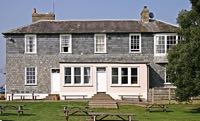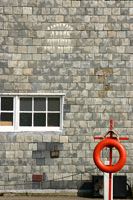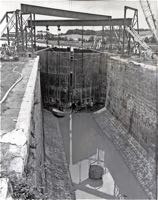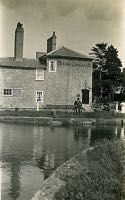
The Turf Locks Hotel
Page updated 28th March 2018
 This hotel is not
actually in Exeter, but its
position at the mouth of the Exeter Ship Canal gives it some importance
to the city. By the early 19th century, the decline of wool exports
along the canal was replaced by imports of coal, timber, salt cod and
other goods.
This hotel is not
actually in Exeter, but its
position at the mouth of the Exeter Ship Canal gives it some importance
to the city. By the early 19th century, the decline of wool exports
along the canal was replaced by imports of coal, timber, salt cod and
other goods.
As early as 1698, the Chamber had considered
extending the canal as far as Powderham or Turfe Poole but opposition saw the
Act of Parliament defeated. It wasn't until the nineteenth century that
James Green was given the task of improving the
canal, so he extended it beyond the Topsham lock and created the Turf
Lock which was opened, along with the extension on 14th September 1827.
Green employed 300 labourers to excavate the canal through very
difficult ground - it ran close to the shore of the Exe as local land
owners would not let him take a direct route. The bank between the
river and the canal proved to be a problem, and had to be continually
raised and strengthened in intervening years. The canal is 15 ft
deep, built parallel with the estuary, had raised banks and was lined
to prevent water loss. The lock itself is 131 feet long and 30 ft
inches wide with a sill 2ft below the bar at Exmouth.
James Green's improvement to the canal and building of Turf Lock
increased the size of vessel that could reach the Port of Exeter.
However, within a few short years, sea going vessels outgrew the canal,
limiting trade. Even the approach to the canal along the Exe estuary
was too shallow for many ships of more than 200 tons. The channel that
led to the Turf Lock was prone to silting, and every spring 1,000 tons
of silt had to be dredged to keep it clear.
During the reign of Edward III, the Alice was recorded as discharging her cargo at Le Torffe. Torf in German is the word for peat, indicating the root of the name. Because of the shifting channels in the estuary, even in the Middle Ages ships often could not reach the port of Topsham and had to unload at Turf.
Turf Locks Hotel
The canal was extended in 1824 by James Green and in 1827, the Turf Locks Hotel was built to provide accommodation for the lock keeper and the crews of vessels using the canal. The hotel had stabling for the horses that were used to tow the barges up and down the waterway. The hotel was built on marshy ground, without adequate foundations and suffers from subsidence, giving uneven floors. It was originally built with only a single toilet.
The keeper of the Turf Locks was also an innkeeper, and to this end, would try and attract visitors to the hotel. In 1868, John Edwards placed several adverts in the Flying Post offering 'Whitebait at Turf' along with tea, ham and eggs and wines and spirits. He would meet parties upon receipt of a letter and convey them to and from the inn for free. The keeper received a salary from the Council which he was allowed to supplement with income from the inn. A few years later, the same keeper, John Edwards was admonished for not only neglecting his duties as a lock keeper, but allowing the grounds to become filthy.
The isolated nature of the Turf Locks meant that mains services were not available. It was not until 1957 that the Turf Locks was given its first electricity supply, when the Navigation Committee approved the purchase of an generator and installation of wiring at a cost of £250 – prior to that it is probable that they relied on oil lamps as the hotel is equally as far from a gas supply as it is from the electricity mains. In 1965, the South West Electricity Board agreed to install mains electricity for the first time under a special scheme recently introduced by the Government to get electricity to remote rural areas.
 The
decline of shipping using the canal in the 20th Century saw the hotel
decline and in the 1970s, the City Council closed it. The Exeter
Maritime Museum had a listed building status applied to the hotel and a
program of restoration undertaken. There is no access for
cars, although there are two ferries from Topsham and a seasonal boat
service from the Double Locks, along the canal. However, cars can
be parked about a mile up the canal, along a road near Exminster. The
fifteen minute walk will work up a thirst and the views are stunning.
The surrounding wetlands and estuary are designated a SIte of Special
Scientific Interest (SSSI) and Special Protected Area (SPA).
The
decline of shipping using the canal in the 20th Century saw the hotel
decline and in the 1970s, the City Council closed it. The Exeter
Maritime Museum had a listed building status applied to the hotel and a
program of restoration undertaken. There is no access for
cars, although there are two ferries from Topsham and a seasonal boat
service from the Double Locks, along the canal. However, cars can
be parked about a mile up the canal, along a road near Exminster. The
fifteen minute walk will work up a thirst and the views are stunning.
The surrounding wetlands and estuary are designated a SIte of Special
Scientific Interest (SSSI) and Special Protected Area (SPA).
In its heyday, the hotel would not only see the passage of many ships up the canal, but the entrance was also busy, as shipping too large for the canal would unload into lighters that would then enter the canal. The basin by the hotel would often be full of ships waiting to be hauled by horse, up the canal to the Canal Basin at Haven Banks, or be waiting for the tide, to pass through the lock into the estuary.
Some trade directory and newspaper entries for the Turf Locks:
1832 - Lower Lock at Turf - reference to 'mine host Lewis' - Flying Post
1859 - Turf Locks - Mr Pearce - Flying Post (reported he wanted to move to the Double Locks)
1868 - 1878 - Turf
Hotel, John Edwards, Exminstr, E - White's
1897 - Turf, Richard Pearse, Exminster, Exeter - Kelly's
1902 - Turf
P. H. Thomas Dixon - Kelly's
1919 - Turf, R. W. Adams, Exminster, Exeter - Kelly's
1923 - Turf, P. N. Taylor, Exminster, Exeter - Post Office
1956 - Turf Locks, Stanley May, Canal Bank - Kelly's.
1990 - Turf
Locks, Clive and Ginny Redfern.

The MV Countess Wear, passes through the lock. The last commercial vessel to use the canal, the tight fit is very apparent.
│ Top of Page │






